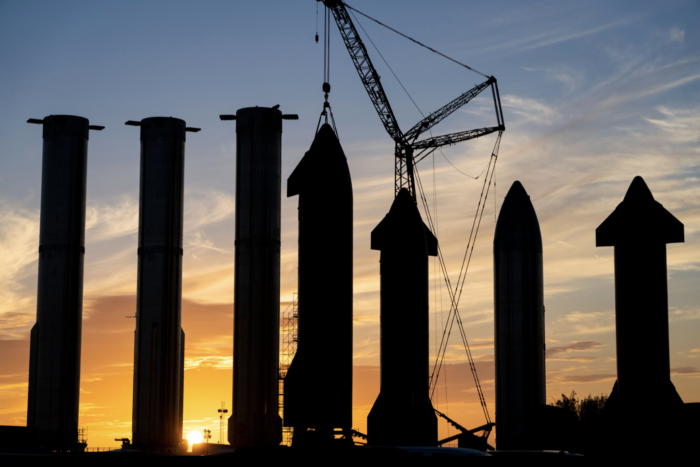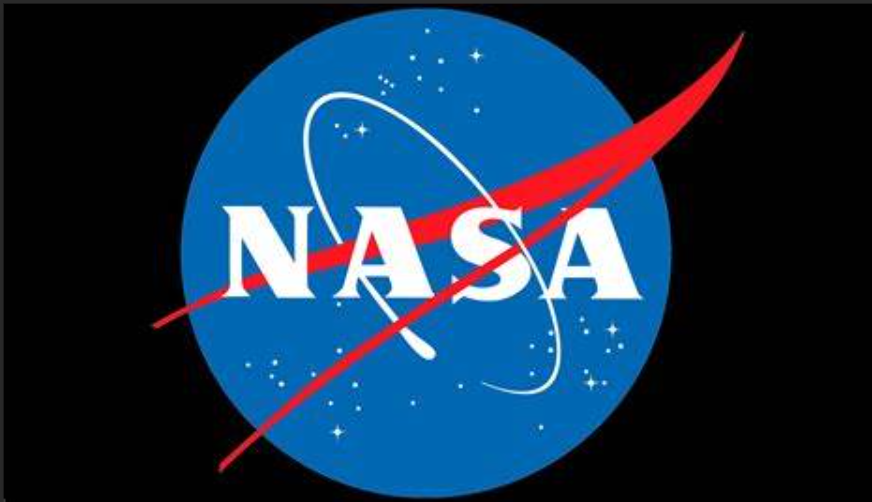by Julia Seibert
At first, nothing happened. As the launch clock approached zero on April 20th, 2023, SpaceX’s prototypical mega-rocket Starship expelled a cloud of gas, lit orange by its engines, but refused to move off its pad. Then, with the spaceflight world holding its breath, it began to climb – slowly, tentatively, like a beast awaking from a deep slumber. Breathing flames tinged with purple, the rocket soared into the skies, losing a handful of engines and throwing in a few physically impressive cartwheels before its flight termination system put an explosive end to the atmospheric antics.
The giant’s short-lived aerial adventure proved a watershed moment in the story of not just SpaceX, but spaceflight in general, for it was the maiden launch of the tallest, most powerful rocket in history – one that is tasked with landing humans on both the moon and Mars, aligning with SpaceX’s goals of interplanetary exploration. While SpaceX’s short-term goals focus on Earth and its orbit, it ultimately hopes to expand humanity’s reach to new worlds, for which Starship will be critical. However, the company faces little competition to do so, and international laws regarding space colonization are vague and unenforceable when it comes to other planets. Whether or not SpaceX accomplishes its mission is one question, but what their impact on humanity’s future might be is another.
In this article, we will delve deep into the fundamental goals and the overarching mission that propel SpaceX on its journey.
Table of Contents
ToggleSpaceX Background
SpaceX was created for Mars. When founder and CEO Elon Musk sold PayPal to eBay in 2002, he decided to use some of his US $180 million bounty to fuel public enthusiasm for exploring our rusty planetary neighbor. Space colonization, so Musk, is the next important step for humanity and would ensure its survival beyond Earth. He first focused his attention on establishing a Martian greenhouse called Mars Oasis; ‘it would get the public excited, and we’d learn a lot about what it takes to sustain plant life on the surface of Mars,’ he wrote. However, it soon became clear that launch costs were exorbitantly high, and neither NASA nor anyone else harbored any Martian ambitions at the time. Musk ditched the greenhouse idea and put US $90 million towards founding Space Exploration Technologies – SpaceX – with the aim of building reusable, cheap, yet equally capable rockets to reduce access costs to space.

It was far from a smooth ride. The fledgling company consisted of just 160 employees at the time of its first launch in 2006; the flight was orchestrated by ‘a tiny crew in T-shirts and flip-flops’ (according to John Antonnen representing DARPA, as reported by Wired). According to Musk, he himself became chief designer ‘because I couldn’t hire anyone. Nobody good would join,’ (as reported by CNBC). The small team quickly learned just how unforgiving the job could be: their Falcon 1 rocket, carrying payloads for DARPA and NASA (plus, on the third flight, human ashes), failed to reach orbit during the first three launches.
By 2008, it seemed all hope was lost. Musk, who was splitting his money between SpaceX and the equally ill-fated Tesla, barely had enough cash left to save one company, let alone two. When the time came for the fourth attempt, it was all or nothing. If it failed, ‘that would have been it for SpaceX,’ so Musk, ‘but fate liked us that day’. Despite a complete mission success in its pocket, SpaceX (and Musk) continued to veer towards bankruptcy – until two days before Christmas, when NASA awarded the company a US $1.6 billion contract for commercial resupply flights to the ISS.
The rest was history. Using a system of vertical integration and rapid design iteration, SpaceX went from a scrawny startup to an industry titan. NASA’s 2008 contract (plus another from 2006) went towards developing the Falcon 9 rocket and Dragon spacecraft, both launching for the first time in 2010. In 2015, SpaceX first landed one of its boosters, which it reused a little over a year later. Reusing boosters and fairings, now par for the course, saves the company a fortune since these make up 60% and 10%, respectively, of the rocket’s roughly US $60 million manufacturing costs (according to Musk’s estimates from 2018 and 2011, so this might have changed somewhat). The company can therefore offer launches at surprisingly cheap prices while still cutting itself a chunky profit.
As a result, flights are selling like hot pies and business is booming. With 61 launches in 2022, SpaceX is set to send 100 rockets to space in 2023; a breakneck cadence like this can save costs and allow them to offer launches in bulk for cheaper. Little competition exists, and Falcon 9 has become the industry’s workhorse. Its beefier sibling Falcon Heavy is also a popular option for missions requiring more power. Many Falcon 9 launches carry satellites for Starlink, SpaceX’s own internet service. As of June 2023, almost 4,700 of these have been launched, constituting over half of the roughly 8,500 working satellites currently in orbit.
Nevertheless, the company’s holy grail is undoubtedly Starship. The rocket is advertised as being capable of lifting 150 metric tons to Low Earth Orbit (LEO) while remaining reusable, and, according to Musk, could cost just US $10 million a launch. Still, there is a long way to go. SpaceX is currently in the development phase of blowing up prototypes to learn what went wrong, and failure is not only an option but part of the process.
SpaceX Goals
1. Affordable Access to Space
SpaceX’s short-term goals quite literally revolve around Earth, and at the heart of them is providing a way to access orbit without breaking the bank. The Falcon 9, priced at US $67 million a launch, is the most popular rocket of the day, launching at least once a week (often more) and dominating the landscape both in and outside the US
SpaceX found a particularly trusty customer in the US government, often launching classified satellites for the Space Force and NRO plus countless missions for NASA (including humans inside the Crew Dragon). Commercial companies’ payloads are also frequently seen sitting atop the rocket; these include touristic trips (facilitated by Axiom, or privately purchased), commercial communications or observation satellites, and dedicated rideshare missions. The latter significantly lowers the access barrier to orbit, priced as low as US $275,000 for a 50kg payload to reach sun-synchronous orbit (SSO).
SpaceX seems to be hitting its mark of providing affordable access to space, but the company is hoping to take things one step further with Starship. If it succeeds, the behemoth would transform the industry by (eventually) offering drastically low prices and allowing massive payloads, such as entire space stations or satellite constellations, to be launched in one go. Therefore, one of SpaceX’s most pressing goals is whipping Starship into shape. Easier said than done, though. Safeguarding the launch pad, getting the rocket into space (with hot staging), figuring out how to refuel it in orbit, and catching it with the launch tower are just a few problems that need to be solved. The rocket must then prove its safety and reliability before becoming an industry regular.

2. Developing and Launching Starlink
Starlink works under the principle of providing globally available fast internet beamed down from a thousands-strong satellite constellation in LEO, aligning with SpaceX’s goals of expanding connectivity worldwide. The company was granted approval from the Federal Communications Commission (FCC) to launch 7,500 of its new Gen2 satellites (which would also offer mobile phone service), despite applying for 29,988 of them. The new satellites are bigger and heavier, meaning a Falcon 9 can launch fewer of them at once; in fact, only the ‘mini’ versions fit on Falcon, with the rest of the constellation relying on the wider payload bay of Starship. As of June 2023, the service is available in 56 countries, costing US $75/month plus US $449-460 for hardware. Starlink has had just one cashflow-positive quarter in 2022, and is hoping to make money in 2023. Maintaining its profitability while developing Starship and building out the constellation constitutes another goal.
The reason for the only partial allowance, as cited by the FCC, were ‘concerns about orbital debris and space safety’. Additionally, astronomers are worried about the reflectivity of the satellites, which can clog up the sky and affect visibility. Radio waves emitted by the satellites’ equipment may also impede radio astronomy efforts. Though Starlink has somewhat addressed these issues by planning collision avoidance maneuvering and darkening satellites, their full extent may not become clear until the whole constellation is launched, which, again, depends on Starship.
3. Bringing Humans to the Moon
SpaceX’s longer-term endeavors, while vaguer than the short, are centered around human spaceflight and reaching new worlds – starting with the moon. In 2021, SpaceX won a US $2.9 billion contract from NASA to provide a human landing system for the third flight of the agency’s Artemis program. The company’s winning design? A Starship, of course, is modified for the lunar environment. In November 2022, SpaceX was granted an additional US $1.15 billion to provide a landing for Artemis IV as well. The plan is for the crew to launch aboard the Orion spacecraft sitting atop NASA’s SLS rocket, then rendezvous with the Starship in lunar orbit for landing. Its 150 metric ton payload capacity (if refueled in Earth orbit) could help bring infrastructure to the moon to help establish the first colonies. However, NASA has voiced concerns regarding Starship’s readiness by Artemis III’s late 2025 launch date, underscoring the technical challenges involved in achieving SpaceX’s lunar mission.
Outside of Artemis, SpaceX offers ordinary lunar missions aboard Starship, too; the rocket has already been contracted by billionaire Yusaku Maezawa for a spin around the moon carrying himself and a crew of creators. Still, SpaceX boasts no large-scale lunar colonization plans of its own, instead describing the moon as ‘an opportunity to gain valuable experience for missions to Mars and beyond.’
Read also: How Are We Going to Colonize The Moon?
4. Bringing Humans to Mars
Mars is the planet SpaceX was founded for. Over the years, rumors, tweets, guesstimates, and ever-changing designs (many of them courtesy of Musk) have shrouded SpaceX’s exact plans in mystery. There seem to be more questions than answers, and even a projected timeline is unclear; Musk recently foresaw 2029 for the first crewed landing, but such estimates are notoriously prone to slipping. What is known is that Starship will play a vital role in fulfilling SpaceX’s mission, and is advertised as being capable of lugging 100 metric tons, or 100 people, to Mars if it refuels in Earth’s orbit. Once there, local Martian resources would be used to replenish the ship’s propellant tanks with liquid oxygen and methane for the return trip. While specific details are yet to be revealed, the ultimate mission of establishing a self-sustaining colony remains at the forefront.

Details aside, before SpaceX’s grand ambitions to establish a colony on the planet take shape, there is considerable groundwork to be laid – and it might not be for the faint of heart. ‘Honestly, a bunch of people will probably die in the beginning,’ said Musk in 2021, likening an early Martian voyage to Artic explorations of the past. ‘You probably won’t have good food and all these things. It’s an arduous and dangerous journey where you may not come back alive, but it’s a glorious adventure.’
5. Colonizing Mars and Setting the Stage for Further Exploration
Once the first colonizers and their balls of steel have broken ground, SpaceX aims to establish a sizable, self-sustaining city on Mars. The pioneering mission requires a mass exodus from Earth. Musk envisions 1,000 Starships, carrying 100 people each, departing Earth at once (likely to occur every 26 months to minimize travel time). He also suggests a cost of US $100,000 per two-way ticket. In the beginning, ships might carry the infrastructure necessary to kickstart a colony, however, Musk’s long-term vision revolves around achieving complete independence from Earth in the long term in case of disaster back home. This means investing in the technology necessary to use locally available resources to sustain life (called in-situ resource utilization), such as using Martian water and CO2 to make rocket propellant.
Life on Mars, with its freezing temperatures, thin atmosphere, and weak magnetic field, would still be quite unpleasant – a problem which Musk addressed by tweeting ‘Nuke Mars!’ and selling T-shirts emblazoned with the phrase. He later explained his intention of using ‘a continuous stream of very low fallout nuclear fusion explosions above the atmosphere to create artificial suns’ to warm the planet, melt its ice, and release trapped CO2 to create a greenhouse effect. Whether or not the strategy is viable is another story, as is trying to guess when it might happen.
6. Strengthening Partnership with the U.S. military
The US government is arguably SpaceX’s most important customer, and one of the company’s goals is expanding this fruitful relationship in the defense sector. Space Force and NRO launches aboard Falcon 9 and Heavy (and possibly Starship) are sure to continue, which SpaceX can charge more for given the extra infrastructure and security measures.
Starlink is another valuable asset. It is playing a vital part in the Ukraine war, and the company is now contracted by the Pentagon for its services in the region. In addition, Starlink has been used in demonstrations by the US Air Force. Eyeing the opportunities in the field, SpaceX introduced Starshield, a military version of Starlink designed for the US government, in December 2022. Though the website is somewhat elusive, these satellites will serve as espionage and communications machines while remaining customizable according to mission specifications. SpaceX (along with L3Harris) is also under contract to build a layer of missile tracking satellites, known as Tranche 0, for the US Space Development Agency. The company launched two of their Tranche satellites aboard a Falcon 9 in March 2023, with two more to follow.
Finally, Starship once again plays into SpaceX’s goals by providing a potential means to traverse the planet in minutes. The US Air Force has awarded SpaceX US $102 million to develop the method, known as point-to-point space transportation. As reported by SpaceNews, the Department of Defense is interested in using the service ‘to support humanitarian aid’, though it is not unthinkable that quick deployment of cargo (perhaps even troops) might be beneficial for other purposes, too. In any case, exactly how one would go about landing a giant rocket in places without designated spaceports remains a topic to be addressed as part of SpaceX’s ongoing pursuit of its goals.
You may also like:
- How Much Does Rocket Fuel Really Cost?
- Top 10 Rocket Launch Companies To Look For in 2023
- How Much is a Rocket Launch?
So, What’s the Ultimate SpaceX Objective?
Ultimately, SpaceX claims that its goal is to make life multi-planetary to ensure the survival of humanity, or, as Musk puts it, the ‘light of consciousness.’ He argues that in order to pass a ‘great filter’ capable of wiping out civilization on Earth, another planetary foothold, so to speak, is needed. This filter might be completely avoidable, such as a nuclear war or climate change, but might also come in the shape of a sizable asteroid headed our way. If detected too late, we stand no chance – a backup drive on Mars means humanity would not need to start from scratch.
Make life multiplanetary to ensure humanity’s survival. Start with mars
SpaceX Future Innovations and Impact on Humanity
If it has any hope of achieving its vision in the foreseeable future, SpaceX has to get its skates on. Just readying the rocket is a herculean task. In addition to hashing out the launching bit, the company must address the bombardment of radiation astronauts are bound to receive on both their trip and their destination, which the current design does not account for. This is just one issue that has to be investigated; the company (or potential future partners) must also figure out exact mechanisms for CO2 and methane extraction on Mars, and how to pack the technology into a rocket (for his part, Musk put US $100 million towards the X-Prize competition for carbon capture and storage methods). Then there is the rest of the technology needed to create and sustain a colony, including building methods, recycling, farming, and medical care. Planetary colonies are hard work.
Aside from the physical needs of the colony, there are the social and political – and these might be much trickier to solve. As noted by Inverse, psychological issues such as cabin fever and even ‘nationalistic infighting’ might occur without proper planning and training. With little chance for outside intervention, a Martian Lord of the Flies situation could be enough to destroy any hope of a colony’s survival if things go awry.
On the political side of things, issues are beginning to make their way to the forefront. Though UN Space Law prohibits claims of sovereignty on celestial bodies, SpaceX is already pushing it. According to Scientific American, Starlink’s Terms of Service not-so-discreetly note that ‘for Services provided on Mars, or in transit to Mars via Starship or other spacecraft, the parties recognize Mars as a free planet and that no Earth-based government has authority or sovereignty over Martian activities. Accordingly, Disputes will be settled through self-governing principles, established in good faith, at the time of Martian settlement.’
What exactly such principles might look like would fuel several sociopolitical Masters theses, but UN Space Law simply remains unenforceable by Earthly parties unless someone else catches up with the technology, and SpaceX have little competition. The potential presence of other companies or countries – who will have their own principles, ideas, rules, and hunger for resources – further complicates the question though.
In spite of the dangers, however, fulfillment of SpaceX’s goals would have a profound impact on humanity. It would all but ensure the species’ survival, providing an insurance policy in case of Earthly disaster. Expanding humanity’s reach would also be a natural progression from exploring our planet’s mysteries and expanding to every corner of it. It would also transform countless Earthly industries as space colonization may introduce space mining technologies, bringing a practically unlimited slew of resources into the picture. Mars and the moon would even serve as better starting points for missions heading even deeper into space, thanks to their lighter gravity. Who ends up in charge of all this remains to be seen. In short, if SpaceX delivers on its lofty goals, humanity will be forever changed. Depending on how it goes about it, this could be for better or for worse.
If you found this article to be informative, you can explore more current space news, exclusives, interviews, and podcasts here.
Featured image: Falcon 9 launch. Credit: SpaceX
Share this article:








